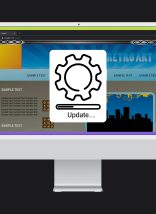Complex projects don’t beat around the bush. They are exactly what they sound like; a large undertaking, layered with a variety of tasks, different people to manage and communicate with, and multiple goals to achieve. How can you make it to the finish line in tact, with so much to juggle? One savvy project manager shows how she stayed cool and found success.
Once upon a time, I was given an assignment I thought would kill me. It was the mother of all complex projects. I was 25 and working as a Senior Project Manager for a small gaming company in NYC. Suddenly, I was to oversee the full development of a $2 million contract.
The video game was being designed to enhance over 400 classrooms throughout the US. It would educate high school students on the subjects of business and accounting. The process was mammoth. We planned for 100 unique characters and needed to write a six-week course curriculum. On top of that, we would provide players with custom-build avatars.
This was the most complex project we had ever tried to tackle, and we realized we had bitten off more than we could chew.
As the Project Manager (PM) I began to ask myself, “Why me?”
In an instant I had the answer to that question: I thrive off of complexity. I enjoy untangling the most complicated, multi-layered project and making it tangible.
What Makes a Project Complex?
It’s important to understand that there is a difference between a complex project and a difficult project.
A complex project isn’t necessarily a difficult one. Projects can be difficult due to cost or performance, but this doesn’t automatically mean that it’s complex. Complexity refers to projects that include ambiguity or uncertainty. They are surrounded by unpredictability. Other indicators of a complex project include:
- Involvement of many teams & stakeholders
- Numerous moving parts
- Project timeline
- Budget & restraints
After identifying the complexity level of your project, it’s time to use your skills to tackle the beast, one bite at a time.
The Essential Skills You Need to Manage Complex Projects
Managing a complex project requires more than the ability to herd cats and spin plates simultaneously. This is just one of the many skills needed for project management. Others include:
- Adaptability
- Collaboration
- Communication
- Expertise
- Leadership
To be successful you must be adaptable. A project is constantly evolving and project managers have to evolve with it. You can’t always think in black and white terms. There will come a time when you have to adjust and flex your management style when the situation changes.
Communication is probably the most important project management skill. Over 90% of a PM’s time is spent communicating. It is essential that PMs can effectively convey vision, ideas, goals, and issues. They also need to produce reports and presentations that are informative and clear.
Communication goes beyond documentation. It also requires building a relationship with your client and your team. If no one trusts you, the project will fail. You must be willing to collaborate with your team. Working with others to get things done is important on all projects, particularly on something that is really challenging. You cannot succeed by yourself. Work with your team and client to achieve success.
Lastly, leadership and expertise go hand-in-hand. If you can lead, you can deliver. Leadership is all about guiding, directing, and motivating your team to do their best work and understand how their tasks contribute to the overall vision.
Leadership comes with experience; neither are skills that can be taught. They only develop over time from real-life, practical work with your team. Having these essential skills is the backbone for identifying what makes a project complex and how to navigate it.
Let’s put these concepts into concrete action.
1. Document. Again. And Again
A project may be broken down into the most perfectly manageable mini-projects. But, without clear documentation on the individual pieces and how they relate to the whole, the project remains opaque to anyone aside from the main project manager.
Clear, up-to-date documentation is the insurance against this issue. It defines everyone’s roles and their deliverables. Also, it ensures that the overall vision isn’t trapped singularly inside someone’s head. If a new hire comes on board during any stage of development, in any role, there needs to be a clear road map outlining where the project has been and where it’s going.
As the project manager, it is your job to document everything. Send out a project status to the full team every week. By providing clear documentation, both your team and your stakeholders can stay informed throughout the entire project lifecycle.
2. Continuously Clarify Your Goals
If you do not understand the “why” behind your project, you will not be successful. Understanding the why brings clarity to the goal(s) of the project. It allows the entire team to find ways to innovate and bring their own areas of expertise to the table.
Project Managers tend to focus on delegating tasks. Our brains fall into a divide and conquer mindset. As the leader, you are expected to paint the bigger picture for your team. Don’t be afraid to push your team outside of their comfort zone. However, remember that people aren’t machines.
If we are constantly delegating tasks without clearly defined goals, our team will fail. It is important to pick our heads up and continuously clarify project goals. When your team understands their roles and the task at hand, they are able to dive directly into execution mode.
Clarify your goals to ensure your project remains aligned with the initial premise—not just once, but continuously. Remember and accept that you will not know all the answers Yet, you can push to explore all possible outcomes and what they would mean for the project.
3. Create More Visibility
When navigating complex challenges, teams often find themselves bogged down in the details. It becomes a struggle to move forward when you’re buried under too much information.
To create more visibility within a project, adapt a management tool that works best for you, your team, and your client. This tool will allow everyone on the project to stay informed and see what is happening. Use this as your single source of information. This type of tool will provide real-time insight into the decisions and activities that are relevant to each member of the team.
Additionally, consider process mapping for complex projects. The process map is a visual representation of the project’s forecasted road map. It allows both our team and our client to know where we are in the project and what activities are planned. Having a physical copy printed and hanging on a wall helps our teams stay on the same page. We are able to point directly to our current status and identify dependencies and risks in real time. This keeps us on track and the client informed.
4. Be Flexible
The only constant in complex projects is change. I don’t care how amazing you think your project plan is, it will change. If you are not willing to adapt and be flexible for the sake of your client, you risk losing them. Plan for unknowns, pivots. and adjustments early on. Be sure to set up processes that allow your team to remain nimble and respond to changing demands.
The single biggest problem in communication is the illusion that it has taken place. -George Bernard Shaw
There is no such thing as over communication for project managers. We have lots of ways to communicate. Even better, the most popular methods don’t require you to open your mouth. Find out what style of communication works best for your project and stick with it.
If digital communication works best, go with it, but never assume your team is reading everything you write. If you are not getting results, be proactive in your communication. There are times when it is necessary to have face to face conversations. It will help ensure the message is not lost through back channels and that the team is clear on the objective.
Moral of the Story
Remember why you do what you do. You may second-guess a decision that you’ve made, but at the end of the day every complex project needs a PM.
The project manager either adds value by making stuff more efficient and effective, or reduces risk because, without a project manager, bad things are going to happen. The PM takes care of communication. He or she is the human shield between you and the development team, ensuring the team can work effectively without too many interruptions.
Never settle and never accept the constraints imposed upon you. Remember that you have more power than you think.
At the end of the day, everything turned out alright with the video game contract I was tasked with. We realized we couldn’t be everything to everyone and hired additional help. Eventually, we launched the game. We ended up creating a high school course curriculum that ran for 6 weeks in over 400 schools nationwide.
We wowed the client.
If you’re someone looking to be wowed by a well-led team, we might know some people…






